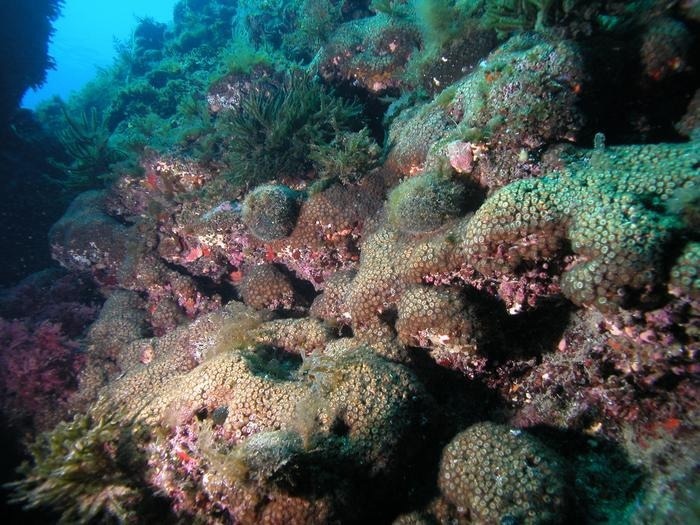A recent study led by researchers from UCL has uncovered a significant discovery: pollutants originating from the combustion of fossil fuels have been detected within corals for the first time. This finding presents scientists with a potential novel method to trace the history of pollution.
 Image Caption: The coral species Cladocora caespitosa. Image Credit: Diego K. Kersting.
Image Caption: The coral species Cladocora caespitosa. Image Credit: Diego K. Kersting.
Published in the journal Science of the Total Environment, the study identified carbon particles emitted from fossil fuel combustion embedded within the corals of Illa Grossa Bay, situated off the Columbretes Islands in the Mediterranean Sea.
The presence of this form of pollution, commonly referred to as fly-ash or spheroidal carbonaceous particles (SCPs), within natural deposits serves as an indicator of human influence on the environment. Furthermore, it acts as a historical marker signaling the onset of the proposed Anthropocene epoch.
Corals serve as a frequently utilized natural archive for paleoclimate investigations due to their measurable growth rates. Similar to tree rings, their extended lifespan and steady growth offer scientists a means to access environmental data on an annual, monthly, or even weekly basis spanning numerous years.
Historically, they have been employed primarily to assess past climatic conditions, such as water temperatures and chemistries. However, this marks the inaugural instance where pollutant particles, apart from microplastics, have been identified within corals.
The discovery of these pollutants embedded in coral skeletons extend over decades and paint a clear picture of how extensive human influence is on the environment. It’s the first time we’ve been able to see this kind of contaminant in corals, and its appearance in these deposits parallel the historic rate of fossil fuel combustion in the region.
Dr. Lucy Roberts, Study Lead Author, Geography, University College London
Corals, small invertebrates typically found in large colonies, absorb SCP pollutants from the surrounding waters, incorporating them into their calcium carbonate skeletons as they grow.
Researchers at the Instituto de Acuicultura de Torre de la Sal (IATS-CSIC) gathered coral samples from multiple sites along a reef situated off the coast of Castelló, Spain. The coral species examined, Cladocora caespitosa, has been under study and observation in the area for two decades, establishing the location as a global change sentinel site.
These corals are positioned approximately 60 km away from the shore within a protected marine reserve, reducing the risk of local contamination. Notably, this species is the sole Mediterranean coral capable of forming extensive reefs and is recognized for its average growth rate of about 0.3 cm per year.
Upon arrival at the lab at UCL, the corals underwent a dissolution process using acid, which left behind any pollutant particulates embedded in the skeleton. Initially, the team meticulously counted all SCPs in the residue using a microscope.
Subsequently, the samples underwent examination under an electron microscope and were analyzed with X-Rays to identify the chemical signatures of SCP contamination, particularly those associated with coal or oil power plants.
The team observed a noteworthy rise in SCP contamination within the corals from around 1969 to 1992. This period coincides with a phase of rapid industrialization in Europe, accompanied by a substantial surge in coal consumption within the region.
These findings are consistent with other assessments of SCP contamination obtained from mountain lakes in Spain, affirming the notion that corals can function as natural repositories to assess fluctuations in pollution levels over time.
These discoveries coincide with a period during which scientists are seeking tools to delineate the onset of the Anthropocene epoch, a geological time unit denoting the most recent age in Earth's history, characterized by human activity emerging as the predominant influence on the planet's climate and environment.
Numerous scientists have proposed employing the presence of SCPs as a marker for the commencement of the Anthropocene, and their detection in coral skeletons lends credence to this proposal. SCPs have already been identified in lake and marine sediments, ice cores, and peat beds, further supporting their potential as indicators of human-induced environmental changes.
As it becomes clearer that humans have altered the natural environment to an unprecedented level, these pollutants act as indelible markers, indicating the start of the Anthropocene epoch. This is valuable to researchers trying to better understand the history of human impact on the natural world and serves as a powerful reminder of how extensive human influence is over the environment.
Dr. Lucy Roberts, Study Lead Author, Geography, University College London
This research was spearheaded by UCL in collaboration with the Instituto de Acuicultura de Torre de la Sal, Spain, and the University of Leicester.
Journal Reference:
Roberts, L. R., et al. (2024). TEMPORARY REMOVAL: First recorded presence of anthropogenic fly-ash particles in coral skeletons. Science of the Total Environment. doi.org/10.1016/j.scitotenv.2024.170665.